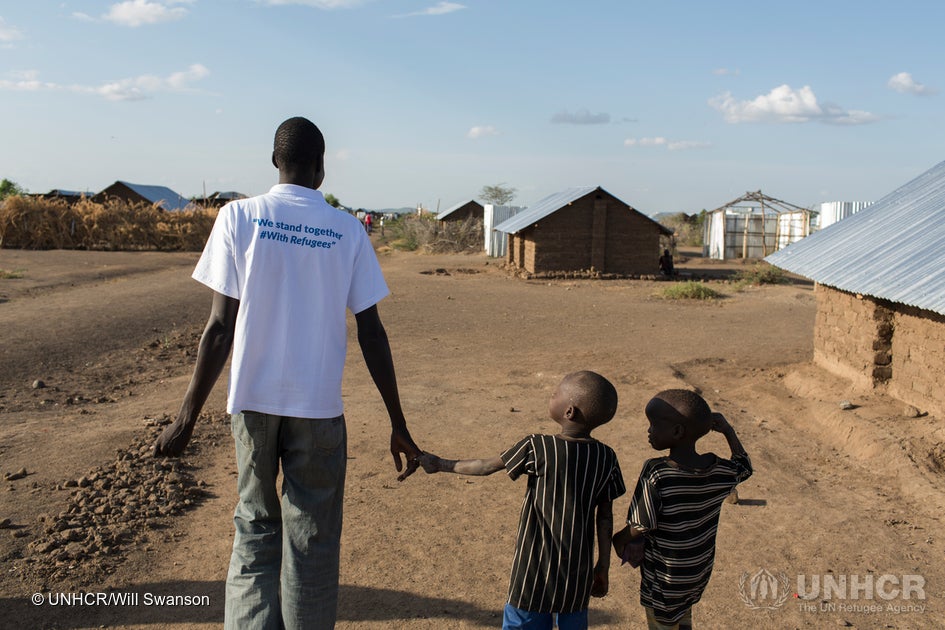
In Kenya, and refugee-hosting countries in Africa, the camp-based protection and humanitarian assistance model has been the default response to the often-protracted forced displacement situations. The underlying assumption has been that it would be impossible or undesirable for refugees to be self-sufficient while waiting for peace to return to their countries of origin.
Therefore, it is not a surprise that refugees from South Sudan and other neighboring countries in north-western Kenya are being assisted in the Kakuma Refugee Camp, which has been hosting refugees since early 1990s. Several waves of refugees have come and gone over the past 25 years, the most recent influx from South Sudan having started in December 2013. The camp has grown into four sub-sections with a capacity of 125,000 persons but a current population of over 155,000. Like in the majority of protracted situations, the care and maintenance programs in Kakuma included providing them with access to shelter, food, water, health care and education.
Under certain circumstances – especially in the context of mass influx – the camp-based assistance model is the most appropriate initial short-term response. Camps offer the possibility to provide effective and efficient health and nutritional interventions to asylum seekers in dire health and nutritional situations.
In the context of protracted displacement situations, however, the camp-based assistance model has had a number of unintended consequences. Most of the refugees in protracted situations end up becoming aid dependent, unable to sustain themselves even after solutions have been found.
For instance, before the eruption of the crisis in December 2013, FAO colleagues in Juba observed that, after over 20 years in the Kakuma, South Sudanese refugees had lost their farming skills. Unable to support themselves, several returnees became part of the urban poor population or resorted to returning to the refugee camps.
If the refugees are aid-dependent, the communities hosting them are often ignored. One of the striking characteristics of the Kakuma Camp is the blatant disparity in living conditions between refugees and the host population. Turkana has the highest level of poverty in Kenya and the refugee programing has not been able to address the pressing needs of the very people providing protection for refugees. As the result of poverty, host community members settle in the periphery of the camp, becoming daily labourers employed by refugees.
Besides being dehumanizing, the camp-based care and maintenance model is no longer financially sustainable. The pot of “humanitarian money” which was used to respond to humanitarian needs around the world is no longer sufficient as new crises erupt and older ones worsen. Providing asylum – one of the oldest traditions of civilizations – was about welcoming people fleeing harm and providing a space to live normally in harmony with others until the decision was made to return or remain. It was not about parking or warehousing people. Somehow this is what an initially well-meaning humanitarian response has become.
It is the need to change the camp-based assistance model that is the rationale behind UNHCR Kenya’s support to the World Bank study: “YES” IN MY BACKYARD? The Economics of Refugees & their Social Dynamics in Kakuma, Kenya. Using a ground-breaking methodology, the task team collected social and economic data and analysed the socio-economic impact of hosting refugees in Turkana.
In addition to filling the research gap on this topic, the study’s findings challenged the conventional thinking by showing that refugees have boosted overall economic activity and are associated with better nutritional outcomes in the host community. The study’s strength is that it went beyond a generalized impact assessment to present a more nuanced picture using disaggregated data. For example the impact in the market on agriculture and housing is positive, but negative on livestock.
For UNHCR Kenya, the study has been useful in several ways. First, it has provided the data and evidence to improve the quality of – the often emotive – conversation on the issue of refugees in Kenya. Policy makers, government officials at the national and county levels, civil society and other stakeholders can use the findings and evidence of the study to inform the overall conversation on the issue of refugees.
For UNHCR Kenya, the findings of the study will inform our efforts to improve our response to the refugee situation in Turkana. The study’s findings that economic integration of refugees will increase the per capita host incomes by 6% will inform our policy dialogue with the Government of Kenya on the socio-economic rights of refugees. We now can argue that providing refugees in Turkana with the freedom of movement and right to work is not only the right thing to do but also the smart thing to do. Providing refugees the freedom of movement and right to work is not only a human rights and dignity issue, but rather a key policy reform needed to fuel Turkana’s economic growth.
The findings of the study will also inform UNHCR Kenya’s strategic response to both emergency and protracted refugee situations. They are already informing the design and implementation of the Kalobeyei Integrated Social and Economic Development Program (KISEDP), a multi-agency collaboration to develop the local economy and service delivery in refugee-hosting areas of Turkana County. In addition, the study has also paved the way for the collaboration between UNHCR Kenya and the IFC’s Fragile and Conflict-Affected Situations Initiative in Africa Team.
The report "Yes" in My Backyard? : The Economics of Refugees and Their Social Dynamics in Kakuma, Kenya” was supported by the Global Program on Forced Displacement.


Join the Conversation